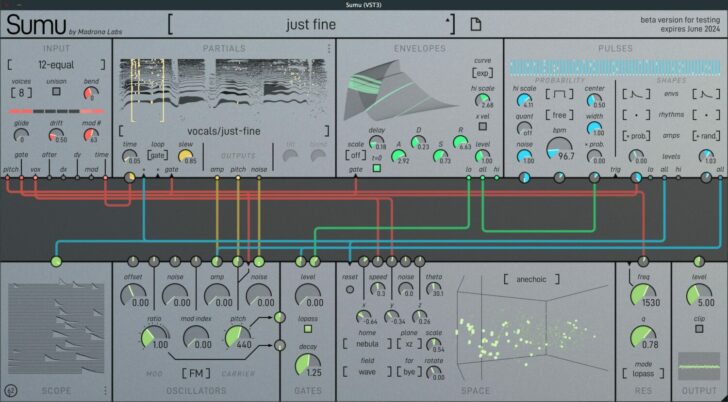Madrona Labs has introduced Sumu, a new software synthesizer for Mac OS and Windows that combines additive resynthesis with FM and vector field spatialization.
In Sumu, sampled sounds are represented as collections of up to 64 bandwidth-enhanced partials, each with a frequency, volume, and noisiness that can change over time. This representation of sound makes all kinds of creative changes possible, from natural-sounding time stretching to exotic timbral manipulations.
Users of Madrona Labs’ other software synthesizers—Aalto, Kaivo, and Virta—will find Sumu’s design familiar, with its fully resizable, vector-based user interface. Every control is on a single page, a design decision intended to support creative flow.
Using the patcher, each partial in a sound can be manipulated independently. While the patcher keeps things simple on the surface, each patch cord has 64 independent channels in it. Sumu has different ways to visualize that data, including the space module, which presents a 3d view of each partial’s location, and a 64-channel scope with bar graph and horizontal wave modes.
Sumu Audio Demo:
Pricing and Availability:
Sumu is available now, with an intro price of $129 USD (normally $179). A demo version is also available.


This is insanely cool sounding!!!
Instant buy. Sound design heaven. Endless audio fun. Time stretching is so powerful and this is crazy town mangle city and beyond. Between this, SynPlant and Myth, my audio world is a very happy place.
100%
The resynthesis performance is very poor. We hear tons of out of control harmonics when it is played back (listen to the demo, and concentrate on the whistles on the background). This is where resynthesis was at about 35 years ago. Things should have improved since then.
been using it for more than 10 hours and i just disagree but ok
Sumu doesn’t do resynthesis – this is done with another software outside the plugin.
The partials map is used to stream data, not audio.
Seems very cool but the demo is absolutely destroying my CPU
same here and blind bought since I have all they other instruments – hoping that release will be a bit more manageable but yikes it’s time 4 me to upgrade.
I hear some inspiring sounds coming from it, but my overall impression is “rabbit hole.” Its modular in an overall sense, because you could chip away at a sound and forget what your goal was. 64 partials could feel like too few for pure additive. With sample-based material, its suddenly not such a limitation. It has a slight Subotnick aroma, with a touch of cinematic FX.
This is so far from my usual slab synths, I’m not sure that I could do it justice. Some instruments say “sound design” very firmly. Others seem designed to suck up a Saturday and make the family mad at you. This one straddles the line!
Resynthesis is underrated – it really needs to make a comeback!